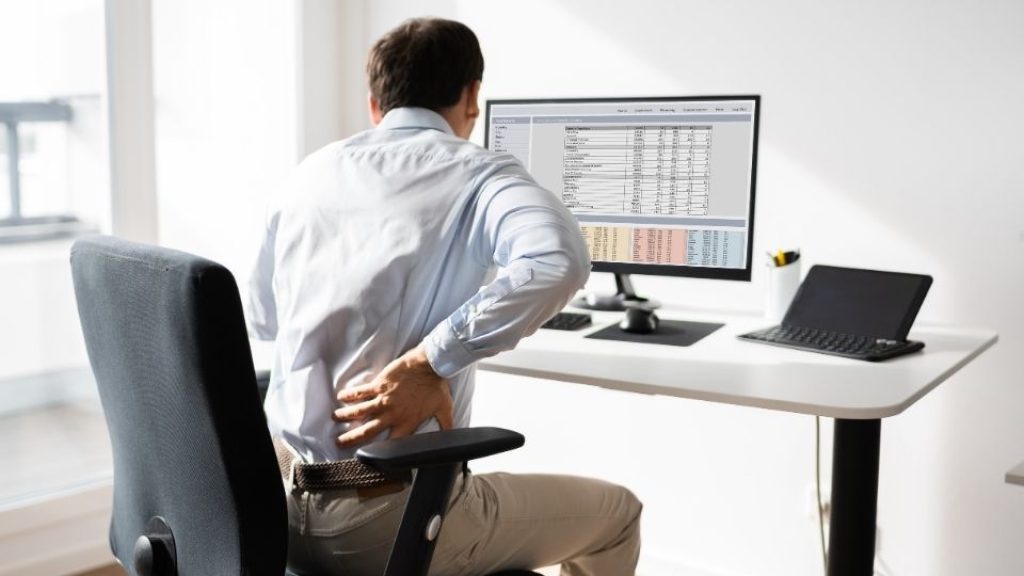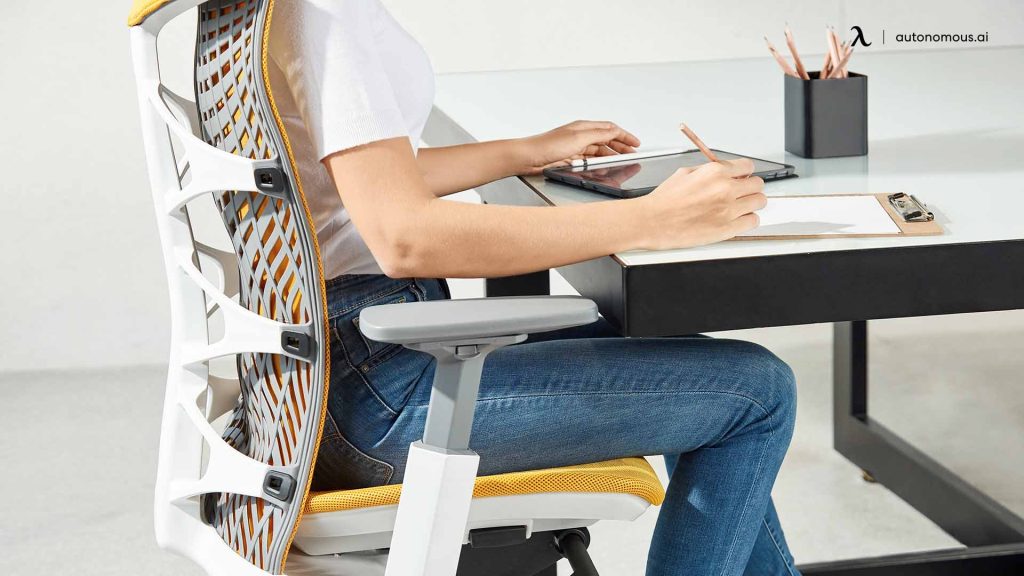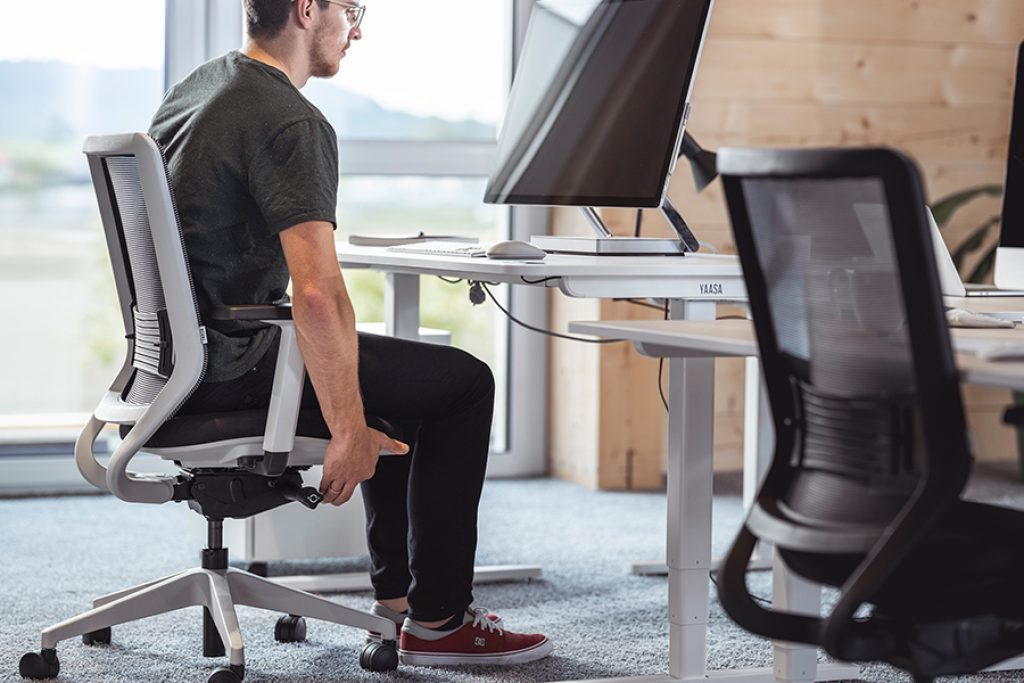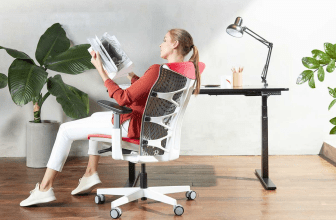Improper sitting places pressure on your lower back, which can lead to long-term discomfort concerns if you sit for long periods of time. Therefore, FittingChairs will show you how to adjust office chair for lower back pain in this article.
What Causes Lower Back Pain When Sitting?

Before we discuss how to adjust office chair for lower back pain, let’s go into the reasons why your lower back hurts when sitting.
Here are some reasons for lower back pain when sitting:
- Prolonged sitting
Sitting for extended periods of time puts tension on the back muscles and spinal discs.
Spinal discs function as cushioning pads between your vertebrae, and pressure on these pads causes pain.
When sitting, pressure is usually at its maximum, and when lying down, it is at its lowest.
- Less activity
The pain from prolonged sitting is aggravated by a lack of physical exercise, which is far more likely to be the daily experience of many since the spreading of the COVID-19 pandemic.
The amount of time we spend at computers for meetings, catching up with friends, and entertainment has increased.
Physical activity has declined, as has access to gyms and fitness facilities. When routines are disrupted, it is often difficult to find the drive to exercise at home.
- Poor posture
Poor posture contributes to this stress by stretching the spinal ligaments and stressing the spinal discs.
Muscles spasm as a result of the increased pressure. This area of our body is already crushed together when we sit, and bad sitting posture increases this slouching, producing strain.
Sitting for long periods of time causes low back discomfort, which is frequently accompanied by neck and shoulder pain.
Let’s move on to how to adjust office chair for lower back pain!
How To Adjust Office Chair For Lower Back Pain

You will need to correctly adjust the office chair to reduce lower back pain in the following ways:
- Support for the lower back
Your lower back should arch slightly and your posterior should be forced up against the back of the chair. If your office chair lacks this arch, you can utilize a lumbar support cushion.
- Measure the angle of the elbows and the work surface
When your hands are on the work surface, your elbows should be at a 90-degree angle. If this is not the case, alter the height of your workplace chair.
When properly positioned, armrests should force your arms to be slightly lifted at the shoulders.
- Measure the distance between your calf and the seat of your workplace chair
Between the edge of the chair and your calf, there should be about a fist-sized amount of space.
If you don’t have enough space, your chair is too deep; if you have too much space, you’ll have to adjust the backward.
- Measure the distance between your thigh and the edge of the chair.
Make sure that you can pass your fingers under your thigh at the office chair edge. If not, you might need to buy a footrest.
- Eye-level
You should be looking at the center of your computer screen or screens. If your sight does not meet the center, the computer screen height may need to be adjusted.
How To Sit With Lower Back Pain?

Many people have jobs that require them to sit for long periods of time. This may seem to aggravate lower back pain, especially if you are unable to exercise frequently.
These are some tips for sitting with lower back pain in order to avoid aggravating this problem.
You must change your body position on a frequent basis to ensure that your muscles are not overworked or under-worked.
By keeping your feet flat on the floor, you may distribute more bodyweight to your legs. This, in turn, can alleviate stress on your back, which may cause pain.
A next tip for sitting that can benefit your back is to keep your knees slightly higher than your hips. If you sit a lot at work, this is one of the simplest things to do.
Sitting for an extended period of time can result in fatigued muscles and poor posture, so get up and move around for a few minutes every 30 minutes or so to avoid these concerns.
How To Reduce Lower Back Pain When Sitting All Day?
Lower back pain can have a significant impact on your day-to-day life. If you’re in persistent pain, it might impair your concentration, increase your tension, and make it harder to enjoy your interests.
Here are some ways to reduce lower back from prolonged sitting:
- Invest in a suitable chair
Choose a chair that allows your feet to rest flat on the floor comfortably. Lower or utilize a footrest if your chair is too high.
Choose a chair that allows your thighs to be parallel to your hips. To keep the spine straight, use a chair with additional lumbar support.
- Create an ergonomic workspace
Use a sit-stand desk that allows you to work in both positions all day.
Make sure your keyboard is positioned such that your elbows are bent roughly 90 degrees and your shoulders are not slumped.
Place your computer screen at eye level so you don’t have to strain to see it.
- Stretch periodically
A few 10- or 15-minute stretching routines several times a day will help keep your muscles supple and limber so they don’t tense up or put undue strain on your spine.
Gentle exercise will also assist to wake up the muscles and get the blood circulating.
Set a reminder on your phone to remind you to get up, walkabout, and stretch every couple of hours.
- Maintain a good posture
You should sit as near to your desk as possible, with your head erect, upper arms parallel to your spine, and hands at a 90-degree angle on your work surface. Your legs should also be at a 90-degree angle, just above your ankles.
You will already be in the correct position if you have appropriately adjusted your workspace in accordance with the aforementioned rules.
Best Chair For Lower Back Pain
After we’ve gone into how to adjust office chair for lower back pain with 5 easy steps, let’s take a look at some of the best chair for lower back pain.
How To Adjust Office Chair Correctly?

You should follow these steps to keep in mind how to adjust office chairs perfectly.
- The seat height
The seat height should be adjusted such that the pressure distribution on the underside of the thighs is as even as feasible. The feet should be totally flat on the floor.
In order to optimize the workplace, the seat height should be adjusted based on the heel height of the shoes. If a height-adjustable table is not available, people with short legs may need to utilize a footrest.
- The seat tilt adjustment
The seat tilt adjustment provides the body with a greater body opening angle. To reduce the possibility of the body falling out of the seat, you should change the angle to 4°.
Regardless of seat tilt, the thighs should sit level and equally on the seat cushion.
- The sliding seat
The office chair may be adjusted to the individual’s thigh-length by pushing the seat back and forth while adjusting it.
On the one hand, the chair should be able to be leaned on the backrest. To guarantee that the pelvis is in touch with the backrest, use the whole surface of the seat.
There should be a three-finger-wide distance between the seat and the back of the knees to prevent pressure from building up in the back of the knees.
- The seat-back mechanism
To properly adjust the backrest, it should not press too hard forwards while also preventing one from falling backward.
The seat-back mechanism is fine-tuned through trial and error so that the entire range of backrest movement supports the upper body in a balanced manner.
Locking the backrest should be utilized sparingly, as dynamic sitting has been shown to improve well-being and work effectiveness. Muscles require a constant cycle of tension and relaxation.
- The height-adjustable backrest
The precise adjustment of an office chair’s backrest, like the correct adjustment of the seat height, assists to produce an equitable distribution of pressure.
The height-adjustable backrest should retain and support the natural double-S form of the spine. Therefore, the lumbar adjustment should not put pressure on the pelvis.
- The armrests
To properly adjust the armrests, the forearms must be allowed to lie flat and the shoulder area must be significantly alleviated.
If the table’s height is suitably adjusted, it can also be used as an armrest, and the armrests can be adjusted downwards.
When using a keyboard and mouse, keep the forearms close to the edge of the table. When altering the width of the armrests, take care not to bend the arms outwards.
How To Adjust The Right Office Chair Posture?
- Adjust the chair height
Set the chair height such that your elbows are at desk height on the underside.
Set the chair to the most comfortable height before adjusting the desk to elbow height if you’re using an adjustable standing desk.
- Adjust the chair angle
Sitting with the seat horizontal or slanted backward offers a nice, relaxing sitting position while keeping proper posture.
Sitting at a slight angle in a forward position toward the desk releases strain beneath the thighs, allows for a more open hip angle, and improves back posture.
- Adjust the backrest height
The height settings for the backrests are all different. It’s possible that you’ll need to release a lever or knob at the backrest’s base. You must have a ratchet-style adjustment if your chair has no knob or level.
- Adjust the armrest height
Armrests contribute to bad posture by preventing people from sitting as close to the desk as they would want.
Position the armrests so that they fit beneath the desk if they can be adjusted. This guarantees that nothing gets in the way of you sitting close and working with your arms relaxed.
- Make sure your feet are firmly on the ground
Sit back in your seat and make sure your feet are firmly on the floor. Appropriate foot support is critical for maintaining good posture and low back comfort.
If your feet aren’t flat on the floor, you’ll need a footrest to improve your posture.
How To Adjust Height Of Office Chair?
Here are three easy methods to adjust the height of the chair:
- Method 1: Raising and lowering a chair
Most office chairs have levers that are attached to the base and are located just below the seat. You can raise the chair by pulling it up on the appropriate level when you’re sitting in it.
Move it around until you find the appropriate spot that works best for you. Gently move the chair only a few inches at a time. When you’re finished, return the lever to its original position.
- Method 2: Choosing the right chair height
When working on a computer, keep your eyes level with the monitor. The monitor should be just below your eye level, and the keyboard should be at elbow level.
When working on a level surface, keep your elbows at the height of the desk. Lower or raise the height of your chair till your elbows and arms are comfortably resting on the desk.
During prolonged periods of sitting, place your feet on the floor.
Change the height of your chair so that your feet are flat on the floor and you don’t have to sit awkwardly.
- Method 3: Increasing safety and comfort
If you’re working at a desk for typing or other relative tasks, lift the armrests till your arms are just about level with the desk.
Every 15-30 minutes, change your seating position. This helps to avoid tension and other problems.
If your chair is too high, invest in a footrest.
How To Adjust Armrest On Office Chair?
Before you choose an office chair, think about the armrest adjustments that are accessible to you.
- Armrest Height
Armrest height is one of the most typical ergonomic chair adjustments. Being able to adjust the height of your armrest can help you avoid discomfort and injury.
- Armrest Width and Pivot
Although not all office chairs have adjustable armrests, those that do can aid with your upper back.
This is normally regulated by a simple button or knob that allows you to tilt your armrests inwards or outwards to varying degrees until you find something that is set to your level of comfort.
That’s all about how to adjust office chair for lower back pain that you should keep in mind to protect your health.
See more:
- 6 Picks of the Best Office Chair for Lower Back Pain You Should Invest
- Office Chairs for Short People You Shouldn’t Miss out On!
- Apply These 6 Methods to Adjust Office Chair Seat Angle
- Choosing the Best Office Chair for Neck Pain: A Complete Guide
Through this article of FittingChairs, we hope you can learn about how to adjust office chair for lower back pain and find it helpful. Don’t forget to share with your friend and family!
Don’t hesitate to comment in the section below if you have any further queries.






